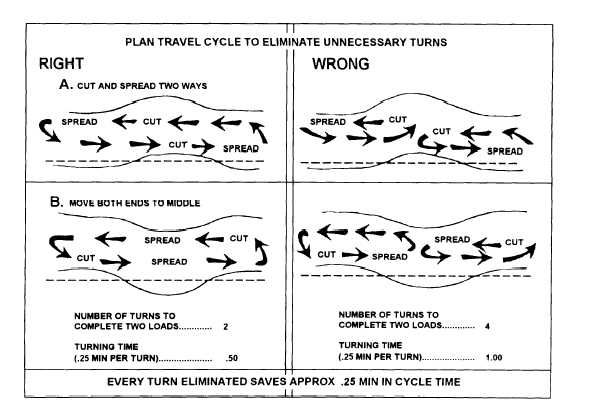a 5-minute scraper cycle time divided by a l-minute
push cat cycle time calls for five scrapers per push cat.
Turns
When making turns, turn within the shortest radius
possible and at the highest safe speed When making
turns to perform cut and spread operations, use the
sequence shown in figure 10-48.
Haul Roads
Haul roads should be level and laid out so time is
not wasted in maneuvering the scraper. A haul road that
has drastic changes in elevation reduces production.
Haul roads should be kept in good condition and moist.
Roads kept moist, not wet, packs into a hard smooth
surface that permits higher travel speeds. The moisture
also controls dust that gets into all parts of the scraper,
resulting in increased lubrication problems and
premature wear.
Additionally, controlling the dust
allows better visibility.
If the haul road is a dirt road and needs grading,
while returning to the cut, maintain the road
occasionally with the scraper blade. This is performed
by opening the apron approximately 12 inches above the
cutting edges and the ejector positioned forward to
within 6 inches of the cutting edge. The bowl is lowered
until the cutting edges scrape about 1 to 2 inches of the
road surface. By watching the road, the operator can
vary the cutting action to trim small rises and carry the
material to fill depressions, as the scraper travels the
haul road These grading operations can be performed
in second or third gear, depending upon road conditions.
Grading should only be done when the road surface has
ruts and rough or soft spots.
NOTE: Scrapers on the haul road should only
travel in the highest gear that is safe for the road
Scraper Spacing Efficiently
Scrapers should be teamed by their speed whenever
possible. The fastest scrapers should be assigned to one
section of a job, while the slower ones are on another.
They should use different haul roads if possible.
NOTE: No scraper can travel faster than the
scraper ahead of it. Passing only increases the chances
of accidents.
Scraper operators can help in traffic control by
speeding up to close along gap and slowing down when
too close. Efficient spacing supports the optimum use
of the push cat. When unloading and lagging far behind
the next scraper, spread the load at the beginning of a
Figure 10-48.-Cut and spread sequence.
10-26


